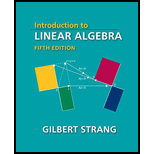
Which of the rule is not satisfied with the given condition of
Answer to Problem 1PS
Explanation of Solution
Given information:
(1) to (4) about
(5) to (6) about
(7) to (8) connects them
We suppose
Then,
and
Clearly, we can see that,
Therefore, the first condition is not satisfied.
and
Clearly, we can see that
Therefore, the second condition is not satisfied.
Since,
Therefore, the third condition is satisfied.
Then,
Therefore, this condition is satisfied.
and
Therefore,
Therefore, his condition is satisfied.
Therefore,
and
Therefore
Therefore, this condition is not satisfied.
Conclusion:
Therefore
Want to see more full solutions like this?
Chapter 3 Solutions
Introduction to Linear Algebra, Fifth Edition
 Algebra and Trigonometry (6th Edition)AlgebraISBN:9780134463216Author:Robert F. BlitzerPublisher:PEARSON
Algebra and Trigonometry (6th Edition)AlgebraISBN:9780134463216Author:Robert F. BlitzerPublisher:PEARSON Contemporary Abstract AlgebraAlgebraISBN:9781305657960Author:Joseph GallianPublisher:Cengage Learning
Contemporary Abstract AlgebraAlgebraISBN:9781305657960Author:Joseph GallianPublisher:Cengage Learning Linear Algebra: A Modern IntroductionAlgebraISBN:9781285463247Author:David PoolePublisher:Cengage Learning
Linear Algebra: A Modern IntroductionAlgebraISBN:9781285463247Author:David PoolePublisher:Cengage Learning Algebra And Trigonometry (11th Edition)AlgebraISBN:9780135163078Author:Michael SullivanPublisher:PEARSON
Algebra And Trigonometry (11th Edition)AlgebraISBN:9780135163078Author:Michael SullivanPublisher:PEARSON Introduction to Linear Algebra, Fifth EditionAlgebraISBN:9780980232776Author:Gilbert StrangPublisher:Wellesley-Cambridge Press
Introduction to Linear Algebra, Fifth EditionAlgebraISBN:9780980232776Author:Gilbert StrangPublisher:Wellesley-Cambridge Press College Algebra (Collegiate Math)AlgebraISBN:9780077836344Author:Julie Miller, Donna GerkenPublisher:McGraw-Hill Education
College Algebra (Collegiate Math)AlgebraISBN:9780077836344Author:Julie Miller, Donna GerkenPublisher:McGraw-Hill Education





